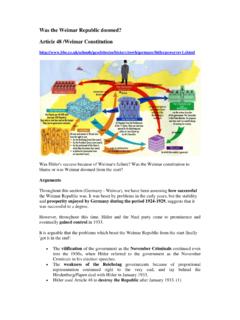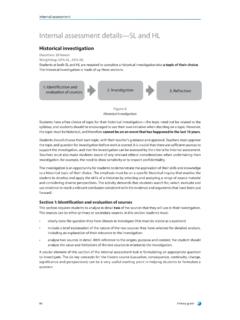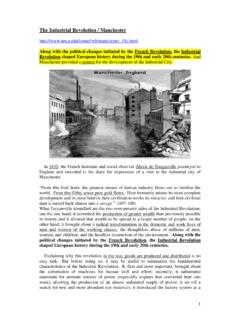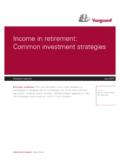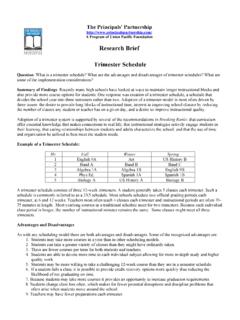Transcription of Latin American History from 1800 to 1914 Outline / Periods
1 Latin American History from 1800 to 1914. Outline / Periods Key words: Trading partner; Americanism, Positivism, Progress; World trade system; Export economy; Liberal regimes; foreign investments;. Labor force; Middle class Party. I. From Colonies to Nations 1800-1824. (By the late 18th century, Creole elites in Latin America were prepared to separate from Spain, but fear of racial and class conflicts prevented successful action. Revolution occurred only after the Napoleonic wars disrupted the government of Spain). II. New Nations Confront Old and New Problems 1824-1850. (Political Fragmentation / Caudillos, Politics, and the Church). III. Latin - American Economies and World Markets, 1820-1870. (Britain's support for the new nations was tied to the opening of trade with Latin America. Britain rapidly replaced Spain as the region's largest trading partner. The dominance of the British hindered the development of Latin American industries and reinforced the economic dependence of Latin America in the world trade network.)
2 From 1820 to 1850, the post independence economy of Latin America remained stagnant. After 1850, in response to European demand for Latin American products, the economy quickened. Enhanced trade permitted greater state development of important infrastructure, such as roads and railroads. The economic growth created support for liberal policies and led to liberal governments after 1860. Creation of a united Argentine 1. Republic in 1862. Liberal reformers sought to manipulate the economic boom after the 1860s. Using profits from increased trade, the liberal government established education systems, built roads, and constructed railroads. The liberal government carried out the final conquest of Indians in Argentina.). IV. Societies in Search of Themselves 1800-1900. ( Latin American culture was torn between the heritage of Europe and the need to express Americanism. The end of Spanish colonial dominance opened Latin America to other European influences in the decades after independence.
3 French neoclassical tradition was particularly influential. Romanticism shifted Latin American attentions to symbols of Americanism, such as Indians, gauchos, and slaves. Historical studies reflected the European concepts of positivism and progress. By the 1870s, the political dominance of liberalism produced more realistic literary efforts, which often criticized social and political systems. Popular culture remained largely unaffected by trends among the elite. Although legal distinctions were often removed, the old social hierarchy based on color and ethnicity was tacitly retained. Indians remained virtually outside the social system of Creoles and mestizos. Socially and economically, the liberal decades led to increasing control of resources, including land, by an elite of white Creoles. After the 1870s, economic change and immigration fostered the creation of greater urban centers, but Latin America remained predominantly agrarian and dependent on the world trade system).
4 V. The Great Boom and uncle Sam goes south, 1880-1920. (The Latin American export economy produced a social and political alliance between large landowners, miners, and export merchants, all of whom depended on commerce for prosperity. Exports dramatically increased between 1870 and 1900. The expanding economy attracted capital from abroad, both from Europe and the United States. Although foreign capital provided the impetus for expansion, it placed Latin American industries and transportation corporations in foreign hands.). Mexico and Argentina: Examples of Economic Transformation Mexico: Porfirio D az, one of Ju rez's generals, was elected president of the Mexican republic. As was typical of liberal regimes, D az's government attracted foreign investment, built up the nation's infrastructure, and initiated industrialization. Although the appearance of democracy was retained, D az's government suppressed all political opposition.
5 Much of the economic growth in Mexico was at the expense of urban laborers and the peasantry, both of which were largely Native American . In 1910, popular dissatisfaction with D az's regime resulted in the Mexican Revolution. Argentina also had a liberal government whose popularity depended on maintaining the boom in the export economy. Unlike Mexico, where labor was provided by indigenous peoples, Argentina's labor force expanded through immigration from Europe. European- born workers brought with them socialism, and a Socialist Party emerged in Argentina in the 1890s. A series of strikes followed by government repression typified the first decades of the 20th century. The middle-class Radical Party promised political reform and enlightened labor policies to gain power in 1916. When faced with strikes, it, too, reacted repressively. The models of Mexico and Argentina (oligarchies composed of the traditional aristocracy and the middle classes uneasily presiding over disgruntled 2.)
6 Laborers and peasants) could be found in other Latin American states where liberal modernization met resistance. Uncle Sam Goes South American capitalists turned to Latin America for investment after the American Civil War. The United States' first armed intervention in Latin America, the Spanish- American War between 1895 and 1898, was intended to open the door to the valuable sugar plantations of the Caribbean. As a result of the war, the former Spanish colonies of Cuba and Puerto Rico were reduced to dependency on the United States. When Colombia proved reluctant to support American plans in Central America, the United States backed Panama's independence movement in return for extensive rights to build a canal in the new nation. Latin American nations became increasingly critical of intervention in the region. Global Connections: New Latin American Nations and the World (During the 19th century, the former colonies of Latin America constructed new nations.
7 There were many difficulties. Latin America was forced to forge economies in a world trade network already dominated by European nations. Unlike much of the developing world, Latin America cast off European imperialism in the 19th century. The new nations carried with them colonial social systems that were strictly hierarchical and in which a small Creole elite dominated the economy and politics. Native Americans, former slaves and peasants shared little in the economic expansion of the second half of the century. In a sense, Latin America was the first region of the world to undergo the problems of decolonization. Latin America maintained ties to the West by imitating Western models and because of the growing influence of the United States. Its dependent economy also kept it connected to the world). 3. Brasil, Cafetal Copyright 1995-2010, Pearson Education, Inc., publishing as Pearson Longman ---------------------------------------- ---------------------------------------- -------------------------- Argentine History / Stages 1852 - 1930.
8 Felix Luna / A short History of the Argentineans Editorial Planeta, 2003. I. 1860-1880. The shaping of institutions Argentina was still sparsely populated but was constantly evolving and, in general terms, improving. It was also receiving a steady immigration. ( ) The international scene was marked by peace and the availability of capital for foreign investments and scientific and technological advances.. 1. Political mechanism in Argentina B. Bartolom Mitre from 1862 to 1868, Domingo Sarmiento from 1868 to 1874 and Nicol s Avellaneda from 1874 to 1880 consolidated the republican system 2. Immigration 3. The wheat and the cold And then there was wheat. The first exports were made in 1878. They were only small but until that year Argentina had generally to import it from the United States. From 1878 onwards there was a small surplus to sell abroad. But in only 30 years it became the most important of Argentine exports.
9 In 1879 a piece of technology of enormous significance appeared: a ship that could transport several tons of frozen lamb to Europe, Le Frigorifique. 4. A year of foundations 1880. 4. 1880 marked the year of the end of the Conquest of the Desert. Second, two significant developments that were unnoticed at the time became a fact of life: the export of small amounts of wheat and the successful preservation of meat in cold storage. Third: Buenos Aires became the Nation s capital under Roca s presidency. II. 1880 - 1916. The shaping of modern Argentina The years between 1880 and 1810 or rather the milestone 1912 S enz Pe a Law have come to be known as the Conservative Order or the Conservative Regime. 1. The Belle Epoque Peace, optimism, unlimited universal progress and liberal politics across the globe, free trade and international business across the globe. 2. A Nation in embryo These three decades witnessed the birth of modern Argentina.
10 Investment, production and consumption placed Argentina among the most advanced countries in South America. It had the longest Railroad network, an admirable educational system and a sizeable middle class and a previously unknown political and institutional stability 3. Ideology In this period Alberdi s ideology was put to practice to create a society that offered the right to gather wealth and educate their children. The parties shared a the policy of opening up the borders of Argentina to the outside world. They introduced new technology like fencing and the Australian Wind mill and modern harvesters. They also promoted cross-breeding of cattle to improve races. Production was so profitable than in thirty years Argentina became the primary exporter of cereals in the world and the second largest exporter of frozen meat after the USA. 4. Debts Capital investment was needed to modernize Argentina. 5.
